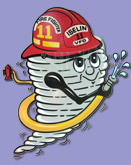|
What is Carbon Monoxide (CO) ? Carbon monoxide is an odorless, colorless and toxic gas. Because it is impossible to see, taste or smell the toxic fumes, CO can kill you before you are aware it is in your home. At lower levels of exposure, CO causes mild effects that are often mistaken for the flu. These symptoms include headaches, dizziness, disorientation, nausea and fatigue. The effects of CO exposure can vary greatly from person to person depending on age, overall health and the concentration and length of exposure. Where does it Come From ? Unvented kerosene and gas space heaters; leaking chimneys and furnaces; back-drafting from furnaces, gas water heaters, wood stoves, and fireplaces; gas stoves; generators and other gasoline powered equipment; automobile exhaust from attached garages; and tobacco smoke. Incomplete oxidation during combustion in gas ranges and unvented gas or kerosene heaters may cause high concentrations of CO in indoor air. Worn or poorly adjusted and maintained combustion devices (e.g., boilers, furnaces) can be significant sources, or if the flue is improperly sized, blocked, disconnected, or is leaking. Why Should You be Concerned ? At low concentrations, fatigue in healthy people and chest pain in people with heart disease. At higher concentrations, impaired vision and coordination; headaches; dizziness; confusion; nausea. Can cause flu-like symptoms that clear up after leaving home. Fatal at very high concentrations. Acute effects are due to the formation of carboxyhemoglobin in the blood, which inhibits oxygen intake. At moderate concentrations, angina, impaired vision, and reduced brain function may result. At higher concentrations, CO exposure can be fatal.
What can you do to protect you and your Family ? Prevention is the first step in ensuring your safety !
It is most important to be sure combustion equipment is maintained and properly adjusted. Vehicular use should be carefully managed adjacent to buildings and in vocational programs. Additional ventilation can be used as a temporary measure when high levels of CO are expected for short periods of time. - Keep gas appliances properly adjusted.
- Consider purchasing a vented space heater when replacing an unvented one.
- Use proper fuel in kerosene space heaters.
- Install and use an exhaust fan vented to outdoors over gas stoves.
- Open flues when fireplaces are in use.
- Choose properly sized wood stoves that are certified to meet EPA emission standards. Make certain that doors on all wood stoves fit tightly.
- Have a trained professional inspect, clean, and tune-up central heating system (furnaces, flues, and chimneys) annually. Repair any leaks promptly.
- Do not idle the car inside garage.
Below are some additional links for further information.
|


